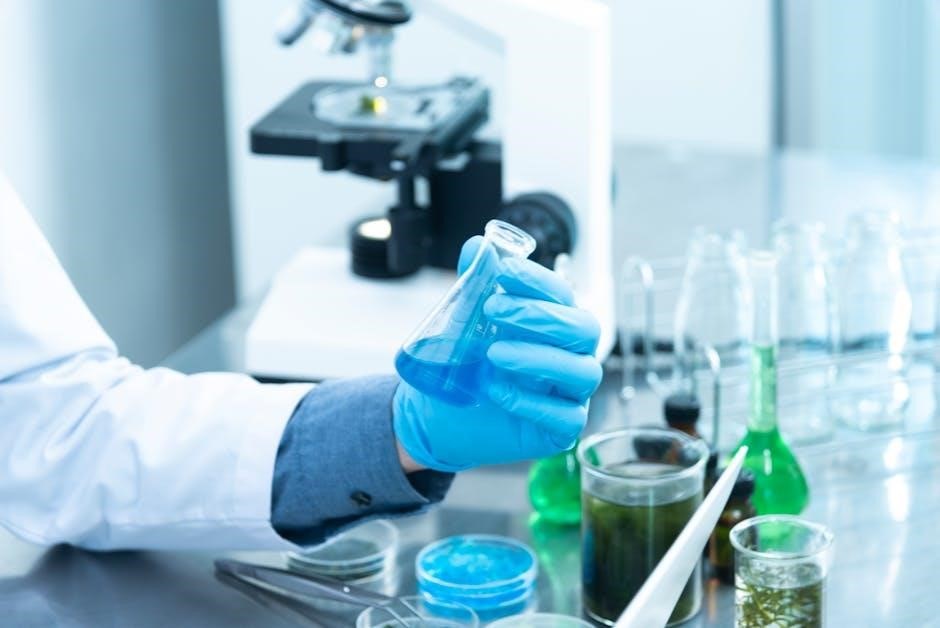microbiology lab manual answer key
This manual serves as a comprehensive guide for microbiology students, offering detailed exercises and techniques to develop essential lab skills. It covers fundamental procedures, safety protocols, and practical applications.
The included answer key provides clear solutions to lab exercises, reinforcing understanding and ensuring accuracy in microbiological techniques, preparing students for future scientific endeavors.
1.1 Importance of Microbiology Lab Manual
The microbiology lab manual is essential for developing practical skills in microbiological techniques. It provides detailed procedures, safety guidelines, and experimental outcomes, ensuring a structured learning experience. Students rely on it to master microbial identification, culturing, and staining methods, making it a cornerstone of laboratory training.
The manual also includes answer keys, enabling students to verify their results and improve accuracy in lab work. This resource is indispensable for building confidence and competence in microbiology practices.
1.2 Overview of the Lab Manual Structure
The microbiology lab manual is structured to provide a logical progression of skills and knowledge. It begins with safety practices, followed by microscopy, culturing, and bacterial identification. Each section includes detailed procedures, expected outcomes, and answer keys for exercises.
The manual is divided into chapters, covering topics like media preparation, aseptic techniques, and waste management. This organization ensures a comprehensive understanding of microbiology laboratory methods and protocols.
Safety Practices in Microbiology Laboratory
Microbiology labs require strict adherence to safety protocols to prevent contamination and exposure to pathogens. Proper handwashing, use of PPE, and safe handling of biological materials are emphasized. Students are advised to avoid eating or drinking in the lab due to the potential risks of bacterial exposure. These practices ensure a safe learning environment.
Lab manuals often include safety guidelines and answer keys to reinforce proper techniques and hazard awareness, ensuring compliance with standard microbiological safety standards.
2.1 Key Laboratory Safety Practices
Key laboratory safety practices include wearing personal protective equipment (PPE), such as gloves and lab coats, to minimize exposure to pathogens. Proper handwashing before and after handling microorganisms is essential. Students are advised against eating or drinking in the lab to avoid accidental ingestion of harmful bacteria. Additionally, all biological waste must be disposed of correctly to prevent contamination and ensure a safe environment.
Adherence to these practices, as outlined in lab manuals and answer keys, helps prevent accidents and ensures compliance with microbiological safety standards, fostering a secure workspace for learning and experimentation.
2.2 Common Hazards in Microbiology Labs
Common hazards in microbiology labs include exposure to pathogenic bacteria, viral contaminants, and biohazardous materials. Improper handling of microorganisms can lead to infections or contamination of lab environments. Additionally, sharps like needles and broken glass pose physical risks. Proper disposal of biological waste is critical to prevent environmental contamination and ensure lab safety, as outlined in lab manuals and answer keys for microbiology students.
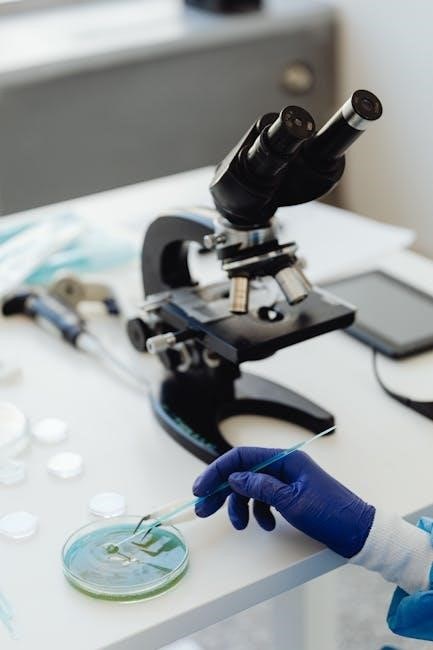
Microscopy Techniques in Microbiology
Microscopy is a key tool in microbiology for observing microbial structures. Techniques like bright-field and phase-contrast microscopy help visualize microorganisms, aiding in the study of their morphology and behavior.
3.1 Types of Microscopes Used in Microbiology
In microbiology, common microscopes include bright-field, phase-contrast, and fluorescence microscopes. Bright-field is standard for observing stained specimens, while phase-contrast enhances contrast for live cells. Fluorescence microscopy uses UV light to detect specific structures or organisms. Each type aids in detailed examination of microbial samples, essential for accurate identification and research.
3.2 Staining Techniques for Microbial Identification
Staining is a critical method in microbiology for visualizing microorganisms. Common techniques include Gram staining, which differentiates bacteria into Gram-positive and Gram-negative groups, and acid-fast staining, used for organisms like Mycobacterium tuberculosis. These methods involve specific dyes and procedures to enhance contrast, aiding in accurate identification. Proper staining ensures clear microscopic observation, essential for understanding microbial characteristics and their classifications.
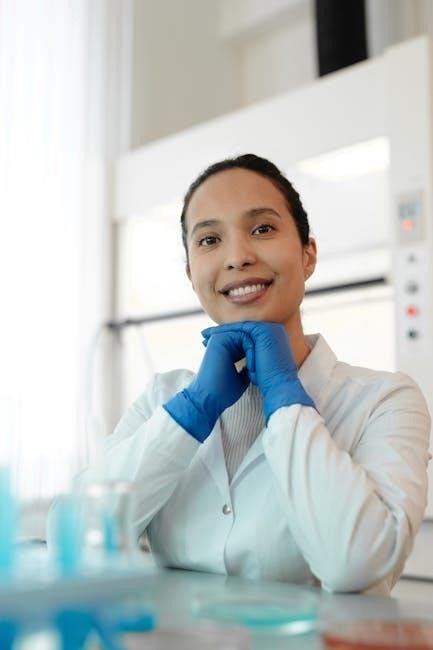
Culturing Bacteria
Culturing bacteria involves growing microorganisms in controlled environments, such as agar plates or liquid media, to study their characteristics and behavior. This process is essential for isolating, identifying, and maintaining bacterial strains, ensuring sterile conditions to prevent contamination and promote healthy growth.
4.1 Preparing Agar Plates for Bacterial Growth
Preparing agar plates involves sterilizing the agar medium, cooling it to a safe temperature, and pouring it into sterile plates under aseptic conditions. Once solidified, the plates are ready for bacterial inoculation and incubation. Proper preparation ensures a nutrient-rich, contamination-free environment for bacterial growth, critical for accurate microbiological studies and experiments. This step is fundamental for successful culturing and analysis of microorganisms.
4.2 Aseptic Techniques for Inoculation
Aseptic techniques are crucial during inoculation to prevent contamination and ensure pure bacterial cultures. These methods include flaming instruments, using sterile loops, and working near an open flame or in a laminar flow hood. Proper hand positioning and minimal movement reduce exposure to airborne contaminants. These practices maintain the integrity of the cultures and are essential for accurate experimental results in microbiology studies.
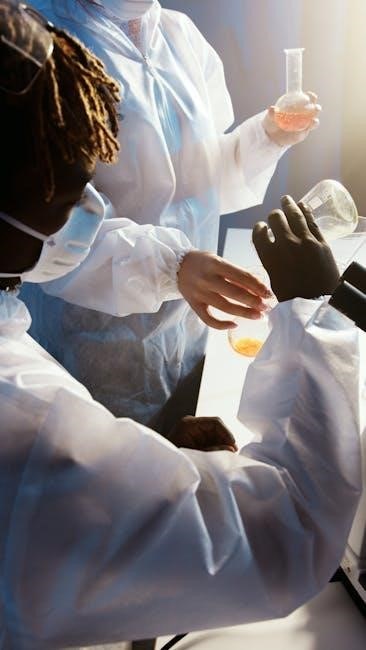
Bacterial Identification Methods
Bacterial identification involves biochemical tests and morphological analysis to determine species. The lab manual provides standardized procedures and answer keys to ensure accurate and reliable identification processes.
5.1 Biochemical Tests for Bacterial Identification
Biochemical tests are essential for identifying bacteria based on their metabolic capabilities. These tests, such as catalase, oxidase, and sugar fermentation, help differentiate species. The lab manual provides detailed procedures and expected results, while the answer key ensures accurate interpretation of test outcomes, aiding students in mastering bacterial identification techniques effectively.
5.2 Using the Lab Manual for Accurate Identification
The lab manual is a vital resource for accurate bacterial identification, providing step-by-step procedures and reference materials. It includes detailed descriptions of biochemical tests, expected outcomes, and interpretation guidelines. The answer key ensures students can verify their results, fostering confidence in their ability to identify microorganisms correctly and consistently.
Media Preparation in Microbiology Labs
Preparing culture media is crucial for microbial growth. The lab manual details recipes and steps for various media types, ensuring optimal conditions for bacterial cultivation and experimentation.
6.1 Types of Culture Media and Their Uses
Culture media are categorized into types like nutrient agar, selective, and differential media, each serving specific purposes in microbial cultivation. Nutrient agar provides essential nutrients for general growth, while selective media inhibit certain bacteria, and differential media help identify species based on metabolic traits. The lab manual’s answer key clarifies these distinctions, aiding students in understanding proper media selection for experiments.
6.2 Steps for Preparing Culture Media
Preparing culture media involves calculating and measuring ingredients, dissolving them in water, sterilizing via autoclaving, and cooling before pouring into plates. The lab manual’s answer key provides detailed instructions, ensuring accurate media preparation. Proper sterilization and aseptic technique are emphasized to prevent contamination. Examples include nutrient agar for general bacterial growth and selective media for specific microbial isolation.
Aseptic and Sterile Techniques
Aseptic and sterile techniques are essential in microbiology to prevent contamination and ensure accurate experimental results. These practices involve using sterilized tools and working in clean environments.
Key practices include handwashing, wearing gloves, and maintaining a sterile field to minimize contamination risks during lab procedures. Proper training is crucial for mastery of these methods.
7.1 Principles of Aseptic Technique
Aseptic technique involves practices that prevent the introduction of microorganisms into a sterile environment. Key principles include proper handwashing, glove usage, and maintaining a sterile field. Instruments and materials must be sterilized before use to ensure contamination-free conditions. These methods are critical for accurate experimental results and safety in microbiology labs, emphasizing precision and adherence to established protocols to avoid cross-contamination risks.
7.2 Sterilization Methods in Microbiology Labs
Sterilization is essential for eliminating all forms of microbial life. Common methods include autoclaving, which uses high-pressure steam, and dry heat sterilization for heat-resistant materials. Ethylene oxide sterilization is applied to heat-sensitive equipment, while filtration is used for liquids. These techniques ensure a contamination-free environment, critical for accurate microbiological experiments and maintaining laboratory safety standards.
Laboratory Exercises and Experiments
This section details exercises designed to develop microbiological techniques, including bacterial growth and identification. The manual guides students through experiments, ensuring skill mastery and practical understanding.
8.1 Common Microbiology Lab Exercises
Common microbiology lab exercises include culturing bacteria, microscopy techniques, and staining methods. These exercises help students master microbial growth, identification, and safety protocols.
Exercises often involve biochemical tests, media preparation, and aseptic techniques. These practical activities enhance understanding of microbial behavior and laboratory best practices.
8.2 Designing Effective Microbiology Experiments
Designing effective microbiology experiments involves clear objectives, controlled variables, and precise methodologies. Students should prioritize reproducibility, safety, and ethical practices.
Experiments often include hypothesis testing, data collection, and analysis. The lab manual provides structured guidance, ensuring experiments align with learning goals and practical applications in microbiology.
Waste Management in Microbiology Labs
Proper disposal of biological waste is critical to prevent contamination and infection. Use sealed containers for hazardous materials and follow autoclaving procedures for decontamination before disposal.
Adhere to lab regulations for safe handling and disposal of infectious agents and chemical waste to maintain environmental and safety standards.
9.1 Proper Disposal of Biological Waste
Biological waste, including cultures and contaminated materials, must be disposed of using autoclaving or incineration. Use biohazard bags for disposal, ensuring all items are securely contained to prevent leakage.
Sharps, such as needles and slides, should be placed in puncture-proof containers. Always follow lab protocols for waste segregation and decontamination to minimize environmental and health risks.
9.2 Handling Hazardous Waste in Labs
Hazardous waste in microbiology labs includes chemicals, disinfectants, and contaminated materials. Proper handling requires segregation into designated containers, ensuring labels are clear and specific to the waste type.
Use secondary containment for transport, and decontaminate surfaces before disposal. Adhere to local regulations and lab protocols to safely manage and dispose of hazardous materials, minimizing risks to health and the environment.
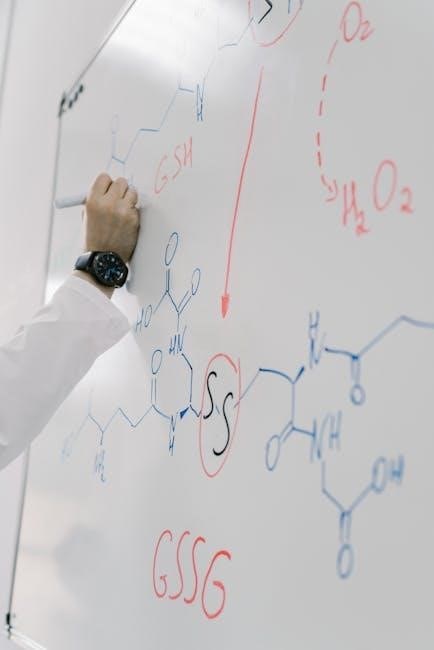
Answer Keys and Study Resources
Answer keys provide students with correct solutions to lab exercises, ensuring accurate understanding. Additional resources, like reference guides and practice exercises, support comprehensive learning in microbiology techniques and procedures.
10.1 Importance of Answer Keys for Students
Answer keys are essential for students to verify their lab work accuracy, reinforcing understanding of microbiological concepts. They help identify errors, improve problem-solving skills, and build confidence in performing complex techniques. By providing clear solutions, answer keys ensure students master procedures, aligning with the manual’s goal of fostering practical expertise in microbiology.
10.2 Additional Resources for Microbiology Students
Additional resources like homework guides and supplementary documents complement the lab manual, offering in-depth explanations and practice materials. These tools enhance learning by providing extra challenges and reference materials, ensuring students grasp complex microbiological concepts effectively.
Best Practices for Lab Work
Adhering to best practices ensures efficiency and accuracy in lab work, emphasizing organization, attention to detail, and strict adherence to protocols for optimal results and safety.
11.1 Effective Note-Taking in the Lab
Effective note-taking in the lab is crucial for accuracy and understanding. Record observations, data, and unexpected results clearly. Use structured formats and ensure legibility. Note materials, procedures, and calculations. Review and organize notes post-session for future reference. This practice enhances reproducibility and supports comprehensive learning, aligning with the lab manual’s answer key for accurate technique mastery.
11.2 Time Management During Lab Sessions
Effective time management is essential for completing lab tasks efficiently. Plan ahead, prioritize procedures, and allocate specific timeframes for each experiment. Minimize distractions and maintain focus to stay on schedule. Proper timing ensures accurate results, safety, and a productive lab experience, aligning with the lab manual’s guidelines for successful outcomes in microbiology studies.
The microbiology lab manual effectively guides students through essential techniques, ensuring a thorough understanding of microbial processes and preparing them for future applications in scientific research and healthcare.
12.1 Summary of Key Concepts
This manual covers essential microbiology techniques, including microscopy, bacterial culturing, and biochemical tests. It emphasizes safety protocols, aseptic practices, and proper waste management. The answer key provides accurate solutions, ensuring students master lab procedures and understand microbial identification methods, reinforcing theoretical knowledge with practical skills for real-world applications in healthcare and research.
12.2 Future Applications of Microbiology Lab Skills
Mastering microbiology lab skills opens doors to careers in disease diagnosis, vaccine development, and environmental science. These techniques are crucial for advancing research in infectious diseases, improving agricultural practices, and ensuring food safety. Proficiency in microbial identification and culturing enables professionals to contribute to public health initiatives and innovate in biotechnology, addressing global challenges effectively.

